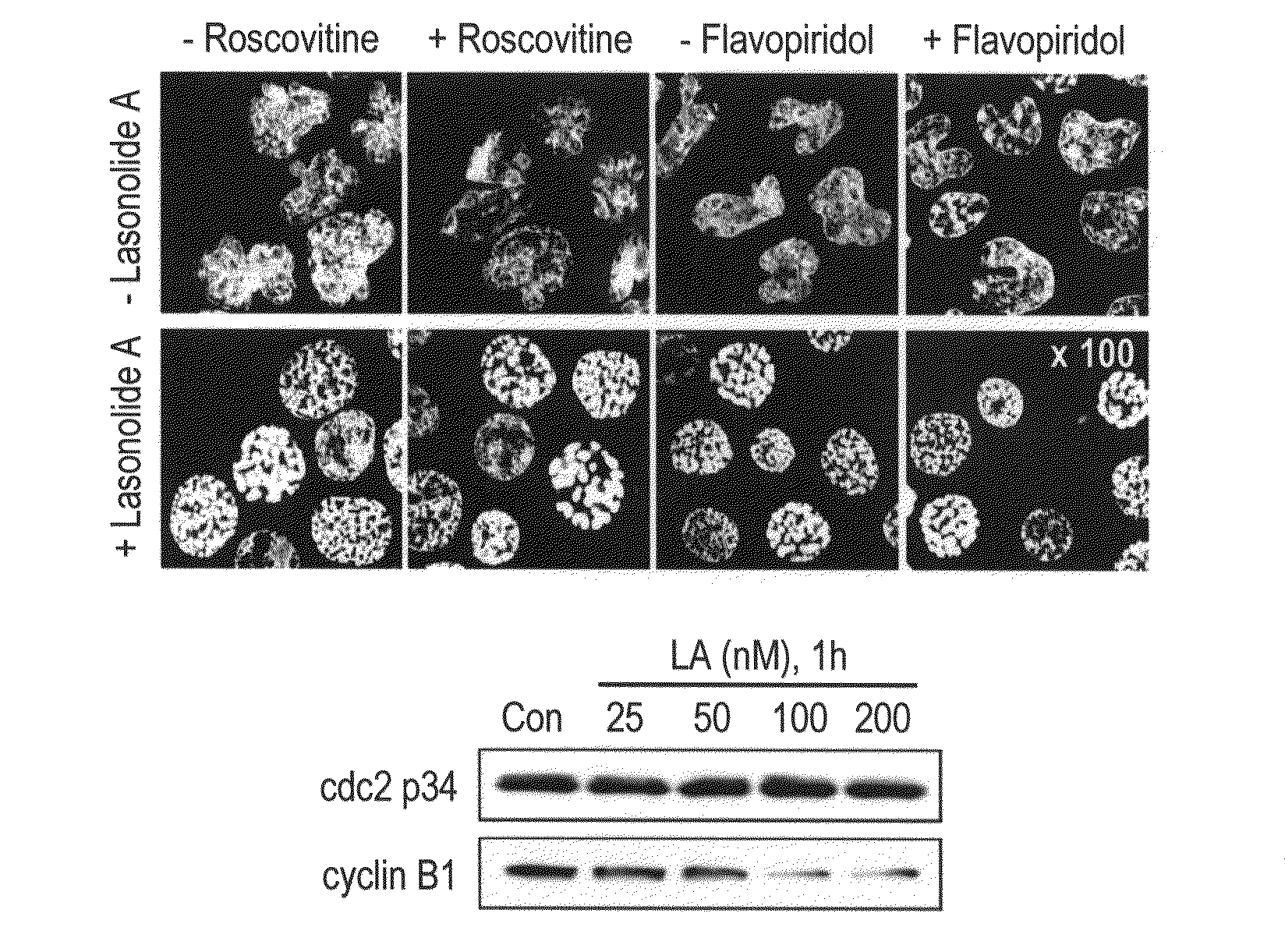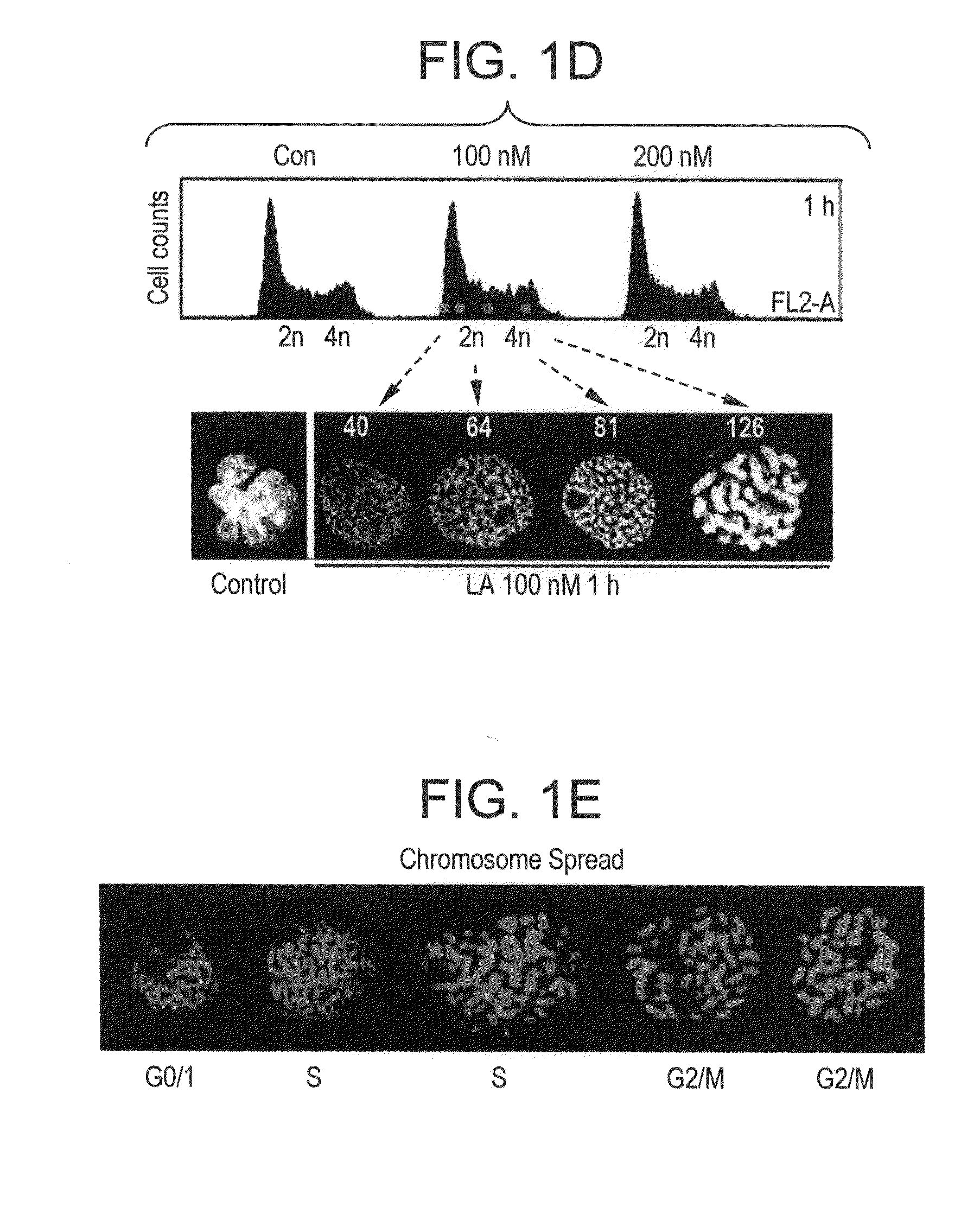Lasonolide compounds as reagents for inducing premature chromosome condensation and methods for treating disorders
- Summary
- Abstract
- Description
- Claims
- Application Information
AI Technical Summary
Benefits of technology
Problems solved by technology
Method used
Image
Examples
example 1
PCC induction and PI staining
[0326]Burkitt's Lymphoma CA46 cells (500,000) (FIG. 1B) or breast cancer MDA-MB-231 cells (500,000) (FIG. 1A) were treated by 100 nM Lasonolide A (stock solution 100 μM in DMSO) for 1 h. Lymphocytes were treated with 200 nM Lasonolide A for 1 h. Cells were harvested with centrifuging on 2,000 rpm for 5 min at 4° C. Pellets were washed once by PBS and re-suspended in 1 mL PBS. 200 μL cells mixture were added to the chamber for cytospining. Cells were cytospun on 800 rpm for 10 min; slides were fixed in fresh-made 4% paraformaldehyde fixation for 20 min at room temperature, then moved to 70% ethanol for 20 min. Slides were stained with Propidium Iodide (“PI”) (20 μg / mL) and RNase A (100 μg / mL) for 15 min. Slides were washed with PBS for three times and mounted with Vectashield anti-fade mounting media (Vector Laboratories, Inc., Burlingame, Calif.). Images were taken using a Nikon Eclipse TE-300 confocal microscope.
example 2
Chromosome Spread Assay
[0327]After the induction of PCC by Lasonolide A, cells were incubated in hypotonic solution (10 mM Tris-HCl [ph 7.4], 40 mM glycerol, 20 mM NaCl, 1 mM CaCl2, 0.5 mM MgCl2) at 37° C. for 15 min. Then followed with cytospining at 1,800 rpm for 10 min and normal PI staining as above (FIG. 1E).
example 3
DNase I Sensitivity Assay
[0328]Cells were treated with different concentrations of Lasonolide A for 1 h and were collected with centrifuging. The centrifuged cells were washed with PBS and fixed with 1.5% PFA for 15 min on ice. After washing by PBS, fresh PBS was added (300 μL) to re-suspend the pellet, then 700 μL 70% EtOH was gently added and the mixture was maintained at −20° C. overnight. The solution was washed by PBS once, then washed by 1× DNase I reaction buffer (500 μL), then incubated in 200 μL Reaction buffer with 4 Units DNase I (2 μL), 37° C., 10 min. The solution was washed by PBS and incubated in 100 μL Polymerase reaction buffer including 16 μM dATP, 16 μM dCTP, 16 μM dGTP, 16 μM dUTP-FITC, 100 unit / mL Polymerase I, 37° C. 60 min. FL1 channel of Green fluorescence signal were measured with flow cytometer (FIG. 1C).
PUM
| Property | Measurement | Unit |
|---|---|---|
| Molar density | aaaaa | aaaaa |
| Molar density | aaaaa | aaaaa |
| Concentration | aaaaa | aaaaa |
Abstract
Description
Claims
Application Information
 Login to View More
Login to View More - R&D
- Intellectual Property
- Life Sciences
- Materials
- Tech Scout
- Unparalleled Data Quality
- Higher Quality Content
- 60% Fewer Hallucinations
Browse by: Latest US Patents, China's latest patents, Technical Efficacy Thesaurus, Application Domain, Technology Topic, Popular Technical Reports.
© 2025 PatSnap. All rights reserved.Legal|Privacy policy|Modern Slavery Act Transparency Statement|Sitemap|About US| Contact US: help@patsnap.com



